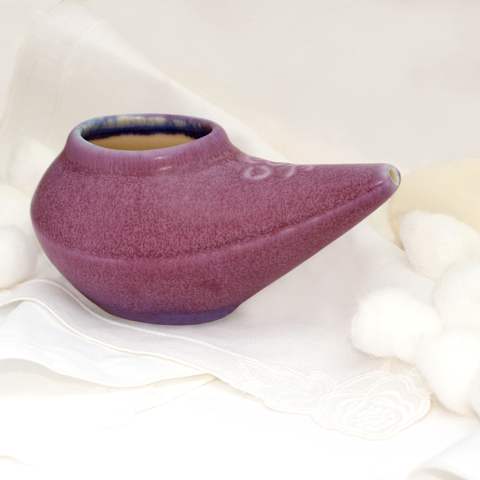Advertisement

There are few things in life that match the simple pleasure of being able to inhale a deep breath of clean, refreshing oxygen through unobstructed nasal passages. We tend to take this glorious feeling for granted most of the time, but when we're robbed of our usual clear airways—whether it's because of intense allergies or a raging sinus infection—we could not be more aware of what we're missing.
These nagging nasal-congesting conditions can send us running to the doctor's office as fast as you can say, "So this is why I have insurance." Medicinal treatments can definitely provide a lot of relief and, in some cases, medicine might be totally necessary. Patients who experience a persistent sinus infection with thick, colored nasal discharge or pressure or pain for 10 or more days, or people whose sinus infections seem to improve before getting worse again, for example, should see their doctors, who may rightly prescribe antibiotics. In most cases, however, even intense sinus infections will clear up on their own in a couple of weeks (it will just be a very mucus-y, sniffly, not fun couple of weeks).
Even though medicine can seem like a quick fix for sinus issues and allergies, you might prefer trying a natural solution. One of the more popular1 natural remedies for allergies and other forms of nasal congestion is the neti pot.
You may have heard of neti pots (and you may have been thoroughly grossed out or confused by what you heard), or maybe you're a chronic allergy sufferer looking for some relief that doesn't involve pumping your body full of antihistamines. Either way, here's what you need to know about neti pots, from where they come from to how to use them properly to the truth behind the stories you might have heard about people dying after using them. As always, check with your doctor before changing your current regimen and trying something new like the neti pot.
What is a neti pot?
It's best to begin with the basics: What exactly is a neti pot? A neti pot is small ceramic or plastic pot that often looks like what you would get if an old-timey teapot had a baby with Aladdin's magic lamp (think: a fat, round base with a very long, curved spout). Neti pots also come in less pot-like designs. Some look like a plastic, modern update on a medieval water bladder or like a water bottle crossed with an electric water pick. Neti pots come in a lot of shapes and sizes, but they all have the same function: to flush your nasal passages with an invigorating dose of salt water.
Neti pots are just one of many methods of saline nasal irrigation2, which is just the technical term for flushing the nasal passages with salt water. Why does pouring salt water through your nose help alleviate the symptoms of allergies and other nasal-congestion-causing conditions? The truth is, scientists don't really know3. Nasal irrigation is a technique that's been used for thousands of years. Its origins likely trace back to ayurvedic medicine, a medical system that originated in India more than 3,000 years ago. Descriptions of methods of and devices for saline nasal irrigation also appeared in the Lancet in 19024.
Even though saline nasal irrigation has been helping humans clear their sinuses for literally thousands of years, scientists can only guess as to why it's so effective. There are, of course, some hypotheses as to why nasal irrigation3 is effective. Most researchers assume that nasal irrigation helps improve mucosal function by directly flushing out thick mucus, crusts, debris, allergens, air pollutants, and more. Nasal irrigation is also thought to help improve congestion by removing elements that cause inflammation and by improving ciliary beat frequency5, which is a key factor in the body's defense of the airways.
The history of the neti pot.
As explained above, origins of nasal irrigation likely trace back thousands of years, to ayurvedic medicine. The system, also known as ayurveda, originated in India more than 3,000 years ago. In ayurvedic medicine, nasal irrigation is known as "jala neti," which likely explains where the neti pot gets its name.
In 1902, descriptions of devices used for saline nasal irrigation also appeared in the Lancet6, a weekly, peer-reviewed medical journal that has been in publication since 1823. Even though the neti pot has clearly been used around the world for centuries now, it (like so many other things) owes its recent surge in popularity to Oprah. In May 20074, Oprah and Dr. Oz demonstrated how to use a neti pot on her show, which brought the device to the attention of millions and kicked off a period of hype1 surrounding the mucus-clearing pot.
Why are neti pots important?
Popularity doesn't always equal importance, but in the case of neti pots, it's definitely relevant. Because they are an increasingly popular option for people with allergies, colds, and sinus issues, it's important to educate yourself on the proper use and the risks7 that are associated with them before you take the leap and try a neti pot yourself.
Neti pots are also important because, well, they work. The risks (described in detail below) are almost nonexistent if the device is used properly, and saline nasal irrigation has been proved effective4 in scientific studies. For people who chronically struggle with allergies and sinus-related issues, neti pots can be a safe, affordable, and very effective alternative to medication or life without the ability to breathe through your nose. As silly as pouring salt water into your nose with a misshapen teapot might seem, it's worth considering if you're looking for healthy, natural methods of relieving nasal congestion.
What are the benefits of using a neti pot?

If used properly, neti pots can help reduce the symptoms of rhinosinusitis, which is just fancy science speak for a stuffy nose (technically, rhinosinusitis refers specifically to inflammation of the nasal cavities, but that inflammation can be caused by anything from allergies to infections).
Neti pots can be used to treat sinuses, colds, and allergies, and, if you're really cool with the process of irrigating your nose with a teapot, a neti pot can even be used simply to moisten the nasal passages when they're dry. The primary and most immediate benefit4 of using a neti pot, no matter what the underlying cause of your stuffy nose, is that it makes it easier to breathe again. By clearing mucus and allergens from the nasal passages, neti pots (and other saline nasal irrigation systems) have the effect of blowing your nose but multiplied greatly. Using neti pots can also help relieve pressure and pain in the sinuses and, of course, save you a bundle on Kleenex purchases.
Another major benefit that makes many swear by neti pots is a greatly reduced need for medication4. Whether you have chronic sinus issues and constantly find yourself hounding your doctor for antibiotics and nasal spray recommendations or you have terrible allergies and an intense antihistamine habit, consistent nasal irrigation could help you manage your symptoms without medicine (or, at the very least, with far less medicine).
One thing to keep in mind? Even those who find relief from neti pot use will likely vary in how long the treatment is effective. In 2009, the publication American Family Physician published a statement recommending neti pot use as a once or twice daily solution for sinus issues. This means that some people can expect at least as little as half a waking day's relief from the treatment.
"Neti pot relief really varies person to person—one may feel better after a few hours, whereas another can get away with a full day," explains Purvi Parikh, M.D., an allergist/immunologist with the Allergy & Asthma Network. "Neti pots cannot hurt, as saltwater often clears our nasal passages and relieves congestion, but effects are temporary, and underlying causes should be addressed. Depending on cause [of congestion], treatments vary. Treating the underlying cause will prevent sinus congestion from coming back, whereas neti pots are a temporary fix."
Deciding whether or not a neti pot is the right form of treatment for you is a personal decision. If you decide to try it out, it's important to go in with an open mind and the understanding that the level of relief varies from person to person, and it may not be an easy fix for your persistent sinus or allergy issues.
What are the risks of using a neti pot?
Now for the cautionary information about neti pots. Like any device being used to treat medical issues, neti pots must be used as directed. Incorrect use can lead to infection and even death—always consult your doctor before you start to use a neti pot to make sure it works with your lifestyle, current medications, and treatment regimen.
Here's the good news, though: Neti pots themselves are actually very safe. They don't carry some bizarre risk of drowning or puncturing your nose from the inside out. The danger with neti pots is actually primarily in the water you use in them7.
The most important rule to remember when it comes to neti pots is not to use tap water. Because it is not adequately filtered or treated, it just isn't safe to use in any kind of nasal rinse, not only with neti pots. Some tap water contains small amounts of organisms like bacteria, protozoa, and amoebas. Before you rush to Amazon to order a lifetime supply of water filters, know that even with these organisms present, tap water is still safe to drink. They are present in such small amounts that the acid in your stomach easily kills them, but when you put that same water in your nose, the organisms can survive and cause some potentially serious infections. Per the Centers for Disease Control and Prevention (CDC)8, these infections can even be fatal in some rare cases.
- Distilled or sterile water, which you can buy in stores, where it will be clearly labeled as distilled or sterile.
- Boiled and cooled tap water. You'll need to boil the water for three to five minutes, and then cool it until it is lukewarm (pouring boiling water through your nose would, obviously, be as dangerous as using unfiltered tap water).
- Water that has gone through a filter that was specifically designed to trap potentially infectious organisms.
Neti pots are also not recommended for use on children under the age of 2, regardless of how clean the water being used in them is.
Neti pot controversy and deaths caused by neti pots.
It's true that neti pots are safe if used correctly, but not everyone has followed safety protocol when flushing their nasal passages. In fact, multiple neti pot users have died after using the device—although the documented deaths were a result of tainted water, not the neti pot itself.
In 2011, two neti pot users in Louisiana died after irrigating with tainted water. The water was tainted with Naegleria fowleri, a type of amoeba. The victims were a 28-year-old man and a 51-year-old woman who both had the bacteria present in their respective homes. The bacteria was found in the man's tankless water heater and in the woman's bathroom sink.
According to the Centers for Disease Control and Prevention9, Naegleria fowleri causes brain swelling and death—which happens within five days in 99 percent of cases. In fact, according to the CDC's records, only one patient out of the 123 known infected individuals in the United States from 1962 to 2011 has ever survived. Contracting the infection is rare but not impossible. The first symptoms of infection include headache, fever, nausea or vomiting, confusion, loss of balance, seizures, and hallucinations.
Although these deaths were caused by tainted water, and not the neti pots the victims used, these cases still underscore the need for users to be careful about the kind of water7 they use with the device.
A step-by-step guide to using a neti pot correctly.
The goal in using any saline nasal irrigation system is the same—to pour liquid saline solution into one nostril and then allow it to drain out of the other4. Here's how you achieve that effect with a neti pot. Again, we can't stress enough how important it is to talk to your doctor before trying it on your own.
Step 1: Clean your neti pot.
Whether it's brand-new, has been sitting in your closet for a while, or was just used yesterday, clean your neti pot before you start any session. Clean it thoroughly with soap and hot water, and allow it to air dry completely before you use it7. This will take a while, so make sure you leave enough time for cleaning your device before you need to use it.
Step 2: Mix up your salt water solution.
Many pharmacies sell prepackaged salt4 for exactly this purpose, and it's honestly probably your best bet, especially if you're new to the neti pot game. You'll need to mix the salt with warm water until it's completely dissolved. Remember, you must use either distilled, boiled and cooled, or specially filtered water7 for your saline solution. Tap water can contain potentially deadly bacteria.
Step 3: Assume the position.
You'll want to use your neti pot over a sink. Lean over the sink4 so you're looking directly into the basin, and then turn your head so that your ear is facing the sink and your chin and forehead are roughly level with each other (it's OK if your forehead is a little higher). At this point, you should start breathing through your mouth, which you'll have to do during the saline rinse in order for it to work.
Step 4: Pour the saline solution.
While breathing through your mouth, you will pour the salt water mixture into your upper nostril4 (the one closest to the ceiling) and tilt your head so that the liquid pours out through your lower nostril (the one closest to the sink). If you notice the salt water starting to drain out of your mouth, lower your forehead relative to your chin to correct the flow. Repeat this process with your other nostril.
Step 5: Clear out remaining mucus.
When you've emptied your neti pot and irrigated both nostrils, exhale softly over the sink to drain any excess liquid from your nose. Then, using a tissue, gently blow your nose to clear out any loosened mucus that might still remain.
Step 6: Clean your neti pot.
Seriously. This is important. Keep your neti pot clean7 and always, always, always use distilled, boiled, or appropriately filtered water for the saline solution itself.
Are neti pots effective?
Research shows that the use of liquid saline nasal irrigation methods (which includes neti pots) has shown to be very effective for treating chronic rhinosinusitis4, in addition to other conditions, like mild-to-moderate allergic rhinitis, rhinitis of pregnancy, and viral upper respiratory infections. For allergy and chronic sinus infection sufferers, these devices can be life-changing, and many people swear by them.
Some research10 does suggest that saline nasal irrigation methods might not be as effective as we previously thought, and that future research should focus on how much coaching is needed to maximize their effectiveness. This would indicate that it's not necessarily that saline nasal irrigation methods aren't effective for relieving symptoms of nasal congestion but that they aren't consistently used properly. If you decide to try a neti pot and feel confused about how it works, or if you're using it correctly, consider making an appointment with an ENT (an ear, nose, and throat specialist, also known as an otolaryngologist) for advice about how to get the most out of your nasal irrigation sessions.
10 Sources
- https://www.tandfonline.com/doi/abs/10.1080/10410236.2015.1047145?tokenDomain=eprints&tokenAccess=YEaWiKfhD896f9kRexZ8&forwardService=showFullText&doi=10.1080%2F10410236.2015.1047145&doi=10.1080%2F10410236.2015.1047145&journalCode=hhth20
- https://www.ncbi.nlm.nih.gov/pubmed/10892694
- https://www.ncbi.nlm.nih.gov/pmc/articles/PMC3904042/
- https://www.ncbi.nlm.nih.gov/pmc/articles/PMC2778074/
- https://www.ncbi.nlm.nih.gov/pmc/articles/PMC2658692/
- https://www.thelancet.com/
- https://www.fda.gov/ForConsumers/ConsumerUpdates/ucm316375.htm
- https://www.cdc.gov/parasites/naegleria/sinus-rinsing.html
- https://www.cdc.gov/parasites/naegleria/general.html
- https://www.ncbi.nlm.nih.gov/pmc/articles/PMC5026511/
Watch Next
Enjoy some of our favorite clips from classes
Enjoy some of our favorite clips from classes
What Is Meditation?
Mindfulness/Spirituality | Light Watkins
Box Breathing
Mindfulness/Spirituality | Gwen Dittmar
What Breathwork Can Address
Mindfulness/Spirituality | Gwen Dittmar
The 8 Limbs of Yoga - What is Asana?
Yoga | Caley Alyssa
Two Standing Postures to Open Up Tight Hips
Yoga | Caley Alyssa
How Plants Can Optimize Athletic Performance
Nutrition | Rich Roll
What to Eat Before a Workout
Nutrition | Rich Roll
How Ayurveda Helps Us Navigate Modern Life
Nutrition | Sahara Rose
Messages About Love & Relationships
Love & Relationships | Esther Perel
Love Languages
Love & Relationships | Esther Perel


















